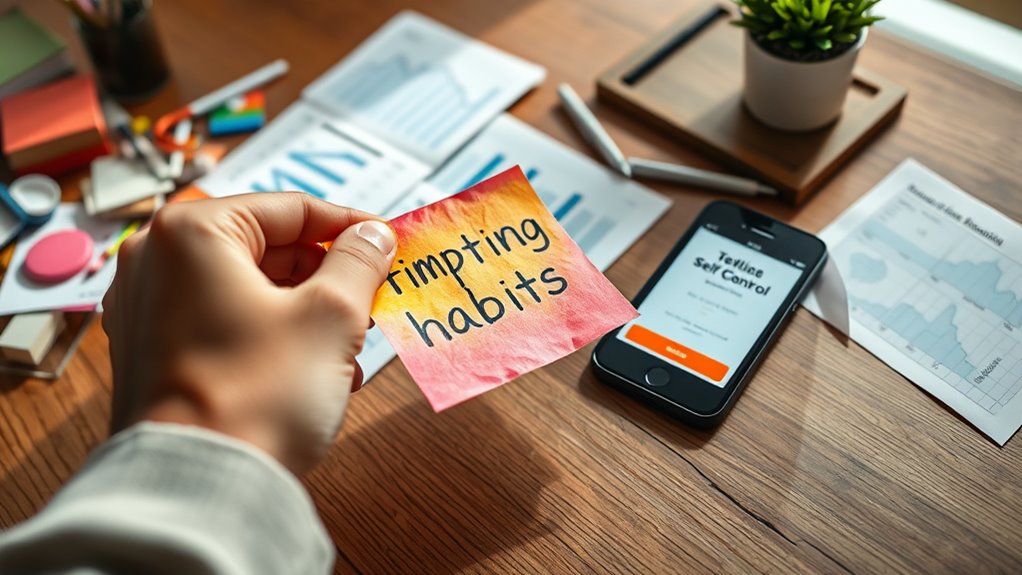Habit Building
Habit Rehearsal & Visualization: Mental Practice for Behavioral Change
Just imagine how habit rehearsal and visualization can transform your behavior—discover the secrets to lasting change and unlock your potential.

Habit rehearsal and visualization are powerful tools to help you rewire your brain and build new behaviors. By actively imagining your desired actions with vivid details, you strengthen neural pathways and boost confidence. This mental practice makes challenging situations feel familiar and attainable, turning intentions into habits. Consistently engaging in these techniques can transform your goals into lasting change, so keep exploring to discover how to leverage these methods for your success.
Key Takeaways
- Mental rehearsal involves vivid visualization of desired behaviors to strengthen neural pathways and rewire the subconscious mind.
- Incorporating sensory details during visualization enhances realism and boosts confidence in executing new habits.
- Consistent mental practice prepares you for challenging situations, reducing anxiety and increasing behavioral mastery.
- Visualizing behavioral cues and decision triggers helps solidify habits, making actions more automatic over time.
- Mindful imagining fosters emotional awareness, allowing you to replace doubts with empowering beliefs and maintain motivation.

Habit rehearsal and visualization are powerful tools that can help you build new habits and achieve your goals more effectively. When you practice mindful imagining, you’re consciously focusing on visualizing yourself performing a desired behavior with clarity and intention. This form of mental rehearsal involves creating vivid mental images, engaging your senses, and imagining the process as if it’s happening in real time. By doing so, you strengthen your neural pathways associated with that behavior, making it easier to act on in real life. Mental rehearsal isn’t just about wishful thinking; it’s a deliberate, focused process that primes your brain for success. When you regularly engage in this practice, you start to rewire your subconscious mind, reducing anxiety and increasing confidence about taking action.
Using mental rehearsal as part of your daily routine helps you simulate situations where you might face challenges or temptations, allowing you to mentally prepare for them. For example, if you’re trying to develop a morning workout habit, you can imagine yourself waking up energized, choosing your workout clothes, and feeling the satisfaction of completing your session. This process makes the actual experience feel more familiar and achievable. Mindful imagining also encourages you to pay attention to your emotional responses during visualization, helping you identify and manage any doubts or negative beliefs that might hold you back. This awareness allows you to replace limiting thoughts with positive, empowering ones, reinforcing your motivation to follow through.
Mentally rehearse challenges to boost confidence and replace doubts with empowering beliefs for lasting change.
Incorporating mental rehearsal into your routine isn’t complicated. Find a quiet space, close your eyes, and take a few deep breaths to center yourself. Then, vividly imagine the steps involved in your desired behavior, paying attention to details like sights, sounds, and feelings. Feel the sense of accomplishment as if you’ve already succeeded. Repeating this process consistently builds a mental blueprint that your brain recognizes as familiar, making the physical action feel more natural over time. It’s like practicing a skill in your mind before performing it in reality, which can dramatically improve your confidence and execution. Additionally, integrating payment solutions and other behavioral cues into your mental imagery can enhance your ability to develop consistent habits related to decision-making and action-taking. Over time, these mental rehearsals help solidify new habits, making it easier to act instinctively rather than relying solely on willpower.
Ultimately, mindful imagining and mental rehearsal aren’t just about wishful thinking—they’re strategic tools that turn your intentions into tangible results. When you harness the power of your mind through focused visualization, you create a mental environment primed for change. This mental practice strengthens your resolve, reduces doubt, and helps you stay committed to your goals, transforming abstract ambitions into concrete habits with consistent effort.
Frequently Asked Questions
How Long Should Each Mental Rehearsal Session Last?
You should aim for each mental rehearsal session to last about 10 to 15 minutes, following the duration guidelines for effective practice. Keep sessions consistent, ideally daily or several times a week, to reinforce your habits. Short, focused sessions are more effective than lengthy ones, helping you stay engaged. Remember, quality matters more than quantity, so make certain you’re fully immersed during each rehearsal for maximum behavioral change.
Can Visualization Replace Physical Practice Entirely?
No, visualization can’t replace physical practice entirely. Mental imagery activates neural pathways similar to actual movement, helping reinforce skills and boost confidence. However, physical practice is essential for fine-tuning motor skills, muscle memory, and real-world application. You should use visualization to complement, not substitute, physical practice—it’s a powerful tool for mental rehearsal, but it works best when combined with hands-on experience for complete mastery.
What Are Common Mistakes to Avoid During Mental Practice?
During mental practice, avoid letting your mind wander, as it can weaken your visualization. Don’t become overconfident—believing mental rehearsal alone guarantees success can lead to complacency. Stay focused and engaged, actively imagining each step vividly. Rehearse consistently without rushing, and make certain your mental images are detailed. By staying attentive and realistic, you maximize the effectiveness of your visualization and reduce the risk of mistakes.
How Often Should I Repeat Visualization Exercises?
You should repeat visualization exercises daily to see meaningful results. Think of it as hitting two birds with one stone—combine mindfulness meditation and motivational affirmations for maximum effect. Consistent practice helps reinforce positive habits and keeps you focused on your goals. Short sessions, about 5-10 minutes, are enough if done regularly. Remember, the early bird catches the worm, so start today and stay committed!
Does Mental Rehearsal Work for All Types of Habits?
Mental rehearsal can be effective for most types of habits, but its success depends on your consistency and the habit’s complexity. By using mental imagery, you activate similar neural pathways as physical practice, aiding habit formation. While it works well for behaviors like public speaking or sports, it might be less effective for deeply ingrained habits. Regular visualization enhances motivation and reinforces your commitment to change.
Conclusion
By practicing habit rehearsal and visualization regularly, you can turn your intentions into reality. These mental techniques strengthen your resolve and make positive change feel more achievable. Are you ready to take control of your habits and transform your life? Remember, each mental rehearsal brings you closer to your goals—so why not start today? Your future self will thank you for the effort you put in now. The power to change is in your mind—are you prepared to use it?
Habit Building
Breaking Bad Habits: Using Behavioral Economics and Self‑Control
Master the secrets to breaking bad habits by harnessing behavioral economics and self-control—discover the key to lasting change and why it matters.

To break bad habits, you need to understand how your brain’s reward systems reinforce them through dopamine and triggers. Use behavioral economics strategies like replacing unhealthy rewards with healthier ones and planning responses to common triggers. Rewiring neural pathways takes consistent effort and strategic changes that focus on self-control, not just willpower. Keep exploring ways to reprogram your habits, and you’ll discover more effective techniques to create lasting change.
Key Takeaways
- Leverage behavioral economics by redesigning environments to reduce triggers and make healthy choices easier.
- Use self-control strategies like implementation intentions and commitment devices to strengthen habit change efforts.
- Replace unhealthy rewards with healthier alternatives that satisfy the brain’s craving for relief or pleasure.
- Anticipate triggers and plan specific responses to disrupt automatic habit loops effectively.
- Understand the reward system’s role in habit formation to rewire neural pathways and foster lasting change.

Breaking bad habits can feel overwhelming, but understanding how they form is the first step to change. When you look at habit formation, you’ll notice it’s a process deeply rooted in your brain’s reward systems. Every time you perform a behavior that offers some form of pleasure or relief, your brain records this as a positive experience, encouraging you to repeat it. Over time, these repeated actions become automatic, driven by cues and triggers that you might not even be fully aware of. This cycle is reinforced by your brain’s reward system, which releases chemicals like dopamine whenever you engage in a habit, making it feel satisfying and reinforcing the behavior. Recognizing this connection is vital because it shows that breaking bad habits isn’t just about willpower; it involves rewiring the reward mechanisms that keep those habits alive.
Understanding how habits form reveals they are driven by reward systems, making change possible through rewiring brain responses.
Once you understand that habits are sustained by reward systems, you can start to manipulate those systems to your advantage. Instead of simply trying to suppress the urge to perform a bad habit, you can replace or modify the reward associated with it. For instance, if you tend to snack mindlessly when stressed, you might replace that with a healthier reward—like taking a short walk or practicing deep breathing. By doing so, you’re still satisfying your brain’s craving for relief or pleasure, but in a way that aligns with your goals. This shift helps weaken the original habit loop, making it easier to form new, healthier routines. It’s important to be patient, because the habit formation process involves creating new neural pathways that compete with existing ones, which takes time and consistent effort.
Furthermore, understanding the role of reward systems can help you anticipate triggers and plan your responses. If you know that certain environments or emotions activate your desire for a bad habit, you can prepare alternative actions that provide a similar reward. For example, if boredom triggers your urge to binge-watch shows excessively, you might set a timer to limit screen time or engage in a more fulfilling activity that offers a sense of accomplishment or relaxation. Additionally, choosing appropriate health-related products like specialized shampoos or oils can support your overall well-being and reinforce positive habits. Over time, these strategic changes help reprogram your reward system, making it easier to resist old habits and develop new, healthier ones.
In essence, breaking bad habits isn’t about sheer willpower alone; it’s about understanding and reconfiguring the reward systems that sustain those habits. When you recognize how habits are formed and reinforced, you gain the power to disrupt the cycle and create lasting change.
Frequently Asked Questions
How Do Habits Form in the Brain From a Behavioral Economics Perspective?
Habits form in your brain when neural pathways strengthen through repeated behaviors, making actions automatic. From a behavioral economics perspective, your reward systems play a key role, as they reinforce behaviors that bring immediate pleasure or relief. Each time you engage in a habit, dopamine releases, strengthening neural pathways and making it more likely you’ll repeat the behavior. Over time, this creates a loop that solidifies habits in your brain.
What Role Do Incentives Play in Breaking Bad Habits Effectively?
Incentives play a pivotal role in breaking bad habits by leveraging reinforcement mechanisms to motivate change. When you align incentives with positive behaviors, you increase the likelihood of sticking to new routines. Effective incentive alignment makes healthier choices more rewarding, helping you override old patterns. By adjusting rewards and consequences, you create a compelling environment that encourages you to break bad habits and develop lasting, beneficial behaviors.
Can Self-Control Be Improved Through Specific Behavioral Strategies?
Can you boost your self-control with targeted strategies? Absolutely. You can strengthen willpower reinforcement by setting clear goals and practicing mindfulness, which helps resist temptations. Habit reversal techniques, like replacing bad habits with healthier ones, also work wonders. These behavioral strategies make self-control more sustainable, making it easier to break bad habits. Isn’t it worth trying proven methods to regain control and improve your habits over time?
How Do Environmental Cues Influence the Development of Bad Habits?
Environmental cues and context triggers strongly influence your bad habits by often signaling when to act without conscious thought. For example, seeing a snack jar might prompt you to snack mindlessly, or stress at work could trigger procrastination. These cues activate habitual responses, making it harder to resist temptations. To break this cycle, identify and modify these environmental triggers, creating new cues that promote healthier behaviors and weaken old, unwanted habits.
What Are Common Pitfalls When Trying to Change Ingrained Behaviors?
You might bite off more than you can chew, which is a common pitfall when trying to change ingrained behaviors. Habit reversal requires consistent effort, but motivation barriers often trip you up. You may underestimate the difficulty or rely on willpower alone, leading to setbacks. To succeed, set realistic goals, build new routines, and stay patient. Remember, change takes time, and persistence pays off even when progress feels slow.
Conclusion
By understanding how your habits form and leveraging behavioral economics, you can outsmart your impulses. The theory suggests that small changes and strategic choices can markedly reshape your behavior over time. Remember, self-control isn’t just about sheer willpower—it’s about designing your environment to make good habits easier and bad habits harder. Trust that consistent effort, combined with smart strategies, can truly break your bad habits and build lasting positive change.
Habit Building
Nutrition Habits: Building Balanced Eating Patterns That Last
Wondering how to create lasting, balanced eating habits? Discover simple strategies to transform your nutrition routines for lifelong health.

To build lasting balanced eating habits, focus on planning your meals ahead to guarantee variety and nutrient density, while practicing mindful eating to enjoy your food and recognize true hunger cues. Start small, like dedicating time weekly for prep, and minimize distractions during meals. Consistency over perfection is key. Avoid spoiled ingredients and stay intentional with your choices. Keep these strategies in mind, and you’ll develop sustainable habits that support your health and well-being over time.
Key Takeaways
- Incorporate meal planning to ensure dietary diversity and prevent impulsive, unhealthy choices.
- Practice mindful eating to enhance awareness of hunger cues and prevent overeating.
- Start with small, manageable steps to build consistent, sustainable nutrition habits over time.
- Focus on balanced meals that include fruits, vegetables, lean proteins, and whole grains.
- Minimize distractions during meals to foster a positive, attentive relationship with food.

Good nutrition habits form the foundation of a healthy lifestyle, influencing your energy levels, immune system, and overall well-being. When you prioritize consistent, balanced eating, you set yourself up for success in many areas of life. One of the most effective ways to develop these habits is through thoughtful meal planning. By dedicating a little time each week to organize your meals, you guarantee that your diet remains diverse and nutrient-dense. Meal planning helps you avoid impulsive choices, reduces the temptation of fast food, and keeps your portions in check. When you plan ahead, you’re more likely to include a variety of fruits, vegetables, lean proteins, and whole grains—building a solid nutritional foundation.
In addition to planning, mindful eating plays a vital role in establishing lasting nutrition habits. Mindful eating encourages you to slow down and pay attention to your body’s hunger and fullness cues. Instead of eating on autopilot or while distracted by screens, you focus fully on the experience of eating—the taste, texture, and aroma of your food. This awareness helps you recognize true hunger versus emotional cravings, leading to healthier portion sizes and reduced overeating. Over time, practicing mindful eating cultivates a respectful relationship with food, making it easier to choose nourishing options naturally.
Combining meal planning with mindful eating creates a powerful synergy. When you plan your meals, you set the stage for balanced choices, but mindful eating ensures you remain present and grateful during each meal. For example, once you’ve prepared a colorful plate of vegetables, lean protein, and whole grains, taking the time to savor every bite reinforces your appreciation for nutritious food. It also helps you detect when you’re actually full, preventing unnecessary calorie intake. This practice fosters a sustainable approach to eating that feels satisfying rather than restrictive. Additionally, understanding spoiled lemon juice signs can help you avoid consuming spoiled ingredients, further supporting your health.
To make these habits stick, start small. Dedicate a few minutes each week to plan your meals and shop with intention. During mealtime, put away distractions and focus on the sensory experience of eating. Over time, these habits become second nature, transforming your approach to food from reactive to intentional. Remember, building balanced eating patterns isn’t about perfection but consistency. By integrating meal planning and mindful eating into your routine, you create a resilient framework that supports your health goals and enhances your overall quality of life.
Frequently Asked Questions
How Can I Stay Motivated to Maintain Healthy Eating Habits Long-Term?
To stay motivated long-term, focus on mindset shifts that emphasize progress over perfection. Find accountability partners who support your goals and help keep you on track. Celebrate small victories to boost your confidence, and remind yourself of your “why” during tough times. By making these changes, you’ll create sustainable habits that become second nature, keeping you motivated and committed to healthy eating every day.
What Are Common Mistakes to Avoid When Building Balanced Diets?
To avoid common mistakes when building balanced diets, focus on proper meal timing and portion control. Don’t skip meals or eat irregularly, as this can lead to overeating later. Watch your portion sizes to prevent consuming too many calories, and aim for consistent eating schedules. Skipping these steps can disrupt your energy levels and hinder progress. Staying mindful of meal timing and portion size helps create sustainable, healthy habits.
How Do I Manage Cravings While Sticking to Nutritious Patterns?
To manage cravings while sticking to nutritious patterns, practice mindful eating by paying attention to hunger cues and savoring each bite. When cravings hit, find healthier alternatives or allow a small portion to satisfy your desire without overindulging. Incorporate craving management strategies like staying hydrated, balancing meals with protein and fiber, and reducing stress. This helps you enjoy treats responsibly while maintaining your balanced eating habits.
Can I Still Enjoy My Favorite Foods Without Compromising Health?
Think of your favorite foods as treasures in your personal map. Yes, you can enjoy them without sacrificing health by practicing meal planning and portion control. When you plan ahead, you set boundaries, like borders on your treasure map, ensuring indulgence stays balanced. Savor small portions, and you preserve the joy of eating your favorites while maintaining your healthy journey. It’s about harmony, not restriction.
What Strategies Help Overcome Emotional Eating and Binge Tendencies?
To overcome emotional eating and binge tendencies, you should practice mindful awareness by paying close attention to your emotions and physical hunger cues. Recognize emotional triggers that prompt overeating, and find healthier ways to cope, such as deep breathing or journaling. Developing these habits helps you stay present, making it easier to resist impulsive eating and build a balanced relationship with food that lasts.
Conclusion
Building balanced eating habits is like tending a garden—you nurture consistently, and over time, you’ll reap a vibrant, healthy harvest. By making mindful choices daily, you create a foundation that supports your well-being for years to come. Remember, small changes can grow into lasting patterns, transforming your relationship with food into a steady, nourishing stream. Stay patient and persistent, and watch your habits blossom into a beautiful, resilient landscape of health.
Habit Building
Sleep Hygiene Habits: Optimizing Circadian Rhythms for Health
The key to better health lies in sleep hygiene habits that optimize your circadian rhythms—discover how consistent routines can transform your sleep quality.

To optimize your circadian rhythms and boost your health, establish consistent sleep habits like going to bed and waking up at the same time daily. Create a sleep-friendly environment by keeping your bedroom cool, dark, and quiet, and avoid screens and stimulating activities before bed. Follow a calming pre-sleep routine and limit fluids at night. Maintaining these routines over time supports better sleep quality and overall well-being—discover more tips that can help you achieve restful sleep.
Key Takeaways
- Maintain a consistent sleep schedule by going to bed and waking up at the same times daily.
- Create a sleep-friendly environment that is cool, dark, quiet, and comfortable to support circadian alignment.
- Establish calming pre-sleep routines, such as reading or gentle stretching, to signal relaxation to your body.
- Limit exposure to blue light from screens at least one hour before bedtime to promote melatonin production.
- Avoid stimulating activities and caffeine close to bedtime to facilitate quicker sleep onset and quality rest.

Getting enough quality sleep is essential for your overall health and well-being, and establishing good sleep hygiene habits can make a significant difference. Your sleep environment plays a vital role in how quickly and deeply you fall asleep, as well as the quality of that sleep. Creating a space that’s cool, dark, quiet, and comfortable helps signal to your body that it’s time to rest. Invest in a supportive mattress and pillows that suit your preferences, and consider blackout curtains or white noise machines if ambient light or noise disrupts your sleep. Avoid screens in the hour before bed, as the blue light emitted can interfere with melatonin production, making it harder to fall asleep. Instead, wind down with calming activities like reading or gentle stretching to prepare your mind and body for rest. Establishing consistent bedtime routines reinforces your body’s internal clock, or circadian rhythm, which regulates sleep-wake cycles. When you follow a regular schedule—going to bed and waking up at the same times daily—you help synchronize your internal rhythms, leading to more restorative sleep. Your bedtime routine should be relaxing and predictable, signaling to your brain that it’s time to unwind. This might include activities such as taking a warm bath, practicing mindfulness or deep breathing exercises, or listening to soothing music. Avoid stimulating activities or caffeine close to bedtime, as they can disrupt your routine and delay sleep onset. Consistency is key; even on weekends, sticking to your sleep schedule helps maintain circadian alignment. When your internal clock is well-regulated, you’ll likely experience improvements in alertness, mood, and overall health. Additionally, your bedtime routines can include limiting fluid intake before sleep to reduce nighttime awakenings and establishing a pre-sleep ritual that mentally prepares you for rest. Keep your bedroom environment dedicated to sleep and intimacy, avoiding work or stressful activities in that space. This helps your brain associate your bedroom with relaxation and sleep rather than alertness or anxiety. Regular sleep hygiene habits support your circadian rhythm and overall sleep quality, making it easier to wake up feeling refreshed. Over time, these habits reinforce a natural sleep-wake cycle that aligns with your body’s needs, making falling asleep easier and improving sleep quality. Remember, good sleep hygiene isn’t about quick fixes but developing a consistent routine that supports your health long-term. By paying attention to your sleep environment and bedtime routines, you’re actively helping your circadian rhythms function effectively, leading to better rest, more energy during the day, and a healthier, more balanced life.
Frequently Asked Questions
How Does Sleep Hygiene Affect Mental Health?
Good sleep hygiene directly impacts your mental health by improving sleep quality, which helps regulate mood and reduce anxiety. When you stick to consistent sleep routines, your circadian rhythms stay aligned, making it easier to manage stress and emotional responses. Poor sleep habits can lead to irritability, depression, and cognitive difficulties. Prioritizing healthy sleep habits allows you to maintain better mental health and overall well-being.
Can Sleep Hygiene Improve Athletic Performance?
Think of sleep hygiene as your secret coach, guiding your body through the night. When you prioritize good habits, you enhance performance recovery and reduce injury risk. Restful sleep rebuilds muscles, sharpens focus, and boosts stamina. By maintaining consistent sleep routines, you set the stage for peak athletic performance. Sleep becomes your unwavering teammate, helping you recover faster and perform better every day.
What Are Common Sleep Hygiene Mistakes to Avoid?
You should avoid common sleep hygiene mistakes like inconsistent bedtime routines and excessive screen time before bed. Staying up late irregularly disrupts your circadian rhythms, making it harder to fall asleep. Manage your screen time by turning off devices at least an hour before bed, and establish a calming bedtime routine to signal your body it’s time to rest. These habits help improve sleep quality and overall health.
How Does Age Influence Sleep Hygiene Needs?
Age affects your sleep like seasons changing—your needs evolve over time. As you age, you experience age-related sleep changes, making it harder to stay asleep or reach deep rest. Your lifespan sleep needs decrease, so you might need less sleep than when you were younger. Adapting your sleep hygiene habits, like maintaining a consistent schedule and creating a calming environment, helps you meet these shifting needs and stay rested.
Are Sleep Hygiene Practices Effective for Shift Workers?
Yes, sleep hygiene practices can be effective for shift workers despite the challenges of irregular schedules. You can improve your sleep by creating a consistent sleep environment, even when your work hours vary. Use blackout curtains, limit caffeine, and establish a pre-sleep routine to signal your body it’s time to rest. These habits help mitigate shift work challenges and support your circadian rhythms, promoting better sleep quality.
Conclusion
By adopting these sleep hygiene habits, you can easily improve your circadian rhythms and overall health. It might seem tough at first, but small consistent changes make a big difference over time. Don’t worry if you slip up—just get back on track the next night. Prioritizing good sleep isn’t about perfection; it’s about progress. With patience and persistence, you’ll find yourself feeling more energized, focused, and healthier every day.
-

 Wish Notes1 year ago
Wish Notes1 year agoBest Caption to Wish Myself a Happy Birthday That Everyone Will Like!
-

 Wish Notes1 year ago
Wish Notes1 year agoThe Best Birthday Wishes to Make Your Uncle's Day Bright!
-

 Wish Notes1 year ago
Wish Notes1 year agoThe Sweetest Happy Birthday Wishes for Your Wife!
-

 Wish Notes1 year ago
Wish Notes1 year agoThe Best Happy Birthday Wish for Your Brother That Will Make Him Smile!
-

 Wish Notes1 year ago
Wish Notes1 year agoHeartwarming Birthday Messages for Mom in Spanish
-

 Wish Notes1 year ago
Wish Notes1 year agoThe Best Happy Birthday Wishes for Your Husband That Will Make His Day!
-

 Wish Notes1 year ago
Wish Notes1 year agoThe Ultimate Birthday Wishes to Celebrate Yourself!
-

 Wish Notes1 year ago
Wish Notes1 year agoThe Most Heartfelt Good Night Wishes Ever!






















